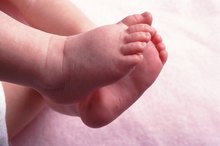Why Do Some Babies Have Hair on Their Backs?
Newborns babies depicted on television and in movies often arrive with rosy cheeks, rounded bodies and clear skin. In reality, many parents find their newborn's appearance somewhat surprising. Your baby probably will emerge from his birth experience with an oddly-shaped head, a scrunched-up body and mottled skin. A waxy, white substance, vernix caseosa, might still coat his skin. He might even appear soft and furry due to a coating of fine hair on his back and other parts of his body.
Lingering Lanugo
Prior to birth, fine, downy hair -- known as lanugo -- covers the bodies of almost all babies. While it might be especially noticeable on their backs and other body parts, pediatrician Dr. Alan Greene notes that it can grow anywhere except for your baby’s palms, the soles of his feet, his penis, nails and the sides of his fingers and toes. Most babies lose this hair shortly before birth, Greene notes, but it can still be present at birth, especially in babies born prematurely.
- Prior to birth, fine, downy hair -- known as lanugo -- covers the bodies of almost all babies.
- Most babies lose this hair shortly before birth, Greene notes, but it can still be present at birth, especially in babies born prematurely.
Protecting Baby's Skin
Infant Skin Discoloration
Learn More
Lanugo helps protect your baby’s skin from drying out in utero. The constant immersion in amniotic fluid could chap and irritate a baby’s delicate skin. Dr. Steven B. Hoath and fellow researchers at the Skin Sciences Institute, researched the role of vernix and lanugo. They found that the tiny, fine hairs of lanugo help keep the vernix caseosa on a baby’s skin where it seals in moisture and serves as a natural skin cleanser, an anti-infective and an antibacterial, wound-healing agent.
- Lanugo helps protect your baby’s skin from drying out in utero.
Time Frame
Your baby develops lanugo 22 weeks into your pregnancy 4. Her eyebrows become apparent around this same time. Most babies lose lanugo hair during the seventh or eighth month of pregnancy, but it might persist for several weeks or even months after birth.
Misconceptions
How to Treat Dry Scalp in Babies
Learn More
Contrary to some common parental fears, lanugo will not regrow after your baby sheds it, and its presence does not mean that your child will have significant body hair as an adult.
Let It Be
Doctors once encouraged parents to rub their baby’s skin to help get rid of the lanugo more quickly, but Greene notes that these types of treatments are not necessary. Rubbing your baby’s skin or applying harsh cleansers can further dry out delicate skin. Since the hair disappears without any type of treatment, ignore the lanugo and care for your baby’s skin as her doctor recommends.
- Doctors once encouraged parents to rub their baby’s skin to help get rid of the lanugo more quickly, but Greene notes that these types of treatments are not necessary.
- Since the hair disappears without any type of treatment, ignore the lanugo and care for your baby’s skin as her doctor recommends.
Related Articles
References
Writer Bio
A former children's librarian and teacher living in Dallas, Erin Carson loves to share her knowledge of both literature and parenting through her writing. Carson has a master's degree in library science and a bachelor's degree in English literature. As a freelance writer, Carson has published numerous articles on various websites.








